Effects of Acoustic Black Hole Parameters and Damping Layer on Sound Insulation Performance of ABH Circular Plate
Abstract
1. Introduction
2. Theoretical Background
2.1. Theory of ABH Circular Plate
2.2. Theory of Transmission Loss
3. Finite element model (FEM) Analysis of Sound Transmission Loss of the ABH Circular Plate
3.1. FEM Model of Vibro-Acoustic Coupling
3.2. FEM Modeling of TL Analysis
3.3. Results of TL Simulation
4. Experimental Validations
5. Effects of ABH Parameters and Damping Layer
5.1. Effect of the ABH Diameter
5.2. Effect of the ABH Orientation
5.3. Effect of the ABH Number
5.4. Effect of the Truncation
5.5. Effect of the Damping Layer
6. Conclusions
Author Contributions
Funding
Acknowledgments
Conflicts of Interest
References
- Bowyer, E.P.; O’Boy, D.J.; Krylov, V.V.; Gautier, F. Experimental investigation of damping flexural vibrations in plates containing tapered indentations of power-law profile. Appl. Acoust. 2013, 74, 553–560. [Google Scholar] [CrossRef]
- Tang, L.; Cheng, L.; Ji, H.; Qiu, J. Characterization of acoustic black hole effect using a one-dimensional fully-coupled and wavelet-decomposed semi-analytical model. J. Sound Vibrat. 2016, 374, 172–184. [Google Scholar] [CrossRef]
- Georgiev, V.B.; Cuenca, J.; Gautier, F.; Simon, L.; Krylov, V.V. Damping of structural vibrations in beams and elliptical plates using the acoustic black hole effect. J. Sound Vibrat. 2011, 330, 2497–2508. [Google Scholar] [CrossRef]
- Conlon, S.C.; Fahnline, J.B.; Semperlotti, F. Numerical analysis of the vibroacoustic properties of plates with embedded grids of acoustic black holes. J. Acoust. Soc. Am. 2015, 137, 447–457. [Google Scholar] [CrossRef]
- Mironov, M.A.; Pislyakov, V.V. One-dimensional acoustic waves in retarding structures with propagation velocity tending to zero. Acoust. Phys. 2002, 48, 347–352. [Google Scholar] [CrossRef]
- Bowyer, E.P.; Krylov, V.V. Sound radiation of rectangular plates containing tapered indentations of power-law profile. In Proceedings of the Meetings on Acoustics 164ASA, Kansas, USA, 22–26 October 2012; Acoustical Society of America: Melville, NY, USA, 2012. [Google Scholar] [CrossRef]
- Bowyer, E.P.; Krylov, V.V. Experimental study of sound radiation by plates containing circular indentations of power-law profile. Appl. Acoust. 2015, 88, 30–37. [Google Scholar] [CrossRef]
- Bowyer, E.P.; Krylov, V.V. Damping of flexural vibrations in turbofan blades using the acoustic black hole effect. Appl. Acoust. 2014, 76, 359–365. [Google Scholar] [CrossRef]
- Feurtado, P.A.; Conlon, S.C. An Experimental Investigation of Acoustic Black Hole Dynamics at Low, Mid, and High Frequencies. J. Vib. Acoust. Trans. ASME 2016, 138. [Google Scholar] [CrossRef]
- Feurtado, P.A.; Conlon, S.C. Transmission loss of plates with embedded acoustic black holes. J. Acoust. Soc. Am. 2017, 142, 1390–1398. [Google Scholar] [CrossRef]
- Feurtado, P.A.; Conlon, S.C. Wavenumber transform analysis for acoustic black hole design. J. Acoust. Soc. Am. 2016, 140, 718–727. [Google Scholar] [CrossRef]
- Ma, L.; Cheng, L. Sound radiation and transonic boundaries of a plate with an acoustic black hole. J. Acoust. Soc. Am. 2019, 145, 164–172. [Google Scholar] [CrossRef] [PubMed]
- Ma, L.; Cheng, L. Topological optimization of damping layout for minimized sound radiation of an acoustic black hole plate. J. Sound Vibrat. 2019, 458, 349–364. [Google Scholar] [CrossRef]
- Li, X.; Ding, Q. Sound radiation of a beam with a wedge-shaped edge embedding acoustic black hole feature. J. Sound Vibrat. 2019, 439, 287–299. [Google Scholar] [CrossRef]
- Ji, H.L.; Wang, X.D.; Qiu, J.H.; Cheng, L.; Wu, Y.P.; Zhang, C. Noise reduction inside a cavity coupled to a flexible plate with embedded 2-D acoustic black holes. J. Sound Vibrat. 2019, 455, 324–338. [Google Scholar] [CrossRef]
- Wang, X.D.; Ji, H.L.; Qiu, J.H.; Cheng, L. Wavenumber domain analyses of vibro-acoustic decoupling and noise attenuation in a plate-cavity system enclosed by an acoustic black hole plate. J. Acoust. Soc. Am. 2019, 146, 72–84. [Google Scholar] [CrossRef]
- Han, B.; Ji, H.; Qiu, J.; Cheng, L. Formation of vibration attenuation in plate by inserting acoustic black hole indentations without damping layer treatment. In Proceedings of the 26th International Congress on Sound and Vibration, ICSV 2019, Montreal, QC, Canada, 7–11 July 2019; The International Institute of Acoustics and Vibration (IIAV): Auburn, AL, USA, 2019. [Google Scholar]
- Hook, K.; Cheer, J.; Daley, S. Optimal feedforward control of a beam with an active acoustic black hole termination. In Proceedings of the 26th International Congress on Sound and Vibration, ICSV 2019, Montreal, QC, Canada, 7–11 July 2019; The International Institute of Acoustics and Vibration (IIAV): Auburn, AL, USA, 2019. [Google Scholar]
- Krylov, V.V. New type of vibration dampers utilising the effect of acoustic ‘black holes’. Acta Acust. United Acust. 2004, 90, 830–837. [Google Scholar]
- Krylov, V.V.; Tilman, F. Acoustic ‘black holes’ for flexural waves as effective vibration dampers. J. Sound Vibrat. 2004, 274, 605–619. [Google Scholar] [CrossRef]
- Deng, J.; Zheng, L.; Zeng, P.Y.; Zuo, Y.F.; Guasch, O. Passive constrained viscoelastic layers to improve the efficiency of truncated acoustic black holes in beams. Mech. Syst. Signal Proc. 2019, 118, 461–476. [Google Scholar] [CrossRef]
- Lee, J.Y.; Jeon, W. Vibration damping using a spiral acoustic black hole. J. Acoust. Soc. Am. 2017, 141, 1437–1445. [Google Scholar] [CrossRef]
- Zhao, L.X.; Conlon, S.C.; Semperlotti, F. Broadband energy harvesting using acoustic black hole structural tailoring. Smart Mater. Struct. 2014, 23, 065021. [Google Scholar] [CrossRef]
- Zhao, L.X.; Conlon, S.C.; Semperlotti, F. An experimental study of vibration based energy harvesting in dynamically tailored structures with embedded acoustic black holes. Smart Mater. Struct. 2015, 24, 065039. [Google Scholar] [CrossRef]
- Bies, D.A.; Colin, H.; Carl, H. Engineering Noise Control, 4th ed.; E&FN Spon: London, UK, 2009; pp. 285–323. [Google Scholar]
- Qu, B.; Zhu, B. Four-microphone Method of Sound Transmission in the Standing Wave Tube. Noise Vib. Control 2002, 22, 44–46. [Google Scholar]
- Dong, L.; Wang, Y.-S.; Guo, H.; Liu, N.-N. Errors in the measurement of transmission loss in a standing wave tube. Noise Control Eng. J. 2017, 65, 174–182. [Google Scholar] [CrossRef]
- Denis, V.; Gautier, F.; Pelat, A.; Poittevin, J. Measurement and modelling of the reflection coefficient of an Acoustic Black Hole termination. J. Sound Vibrat. 2015, 349, 67–79. [Google Scholar] [CrossRef]
- Ma, L.; Zhang, S.; Cheng, L. A 2D Daubechies wavelet model on the vibration of rectangular plates containing strip indentations with a parabolic thickness profile. J. Sound Vibrat. 2018, 429, 130–146. [Google Scholar] [CrossRef]
- Conlon, S.C.; Fahnline, J.B.; Shepherd, M.R.; Feurtado, P.A. Vibration control using grids of acoustic black holes: How many is enough? In Proceedings of the 44th International Congress and Exposition on Noise Control Engineering, INTER-NOISE 2015, San Francisco, CA, USA, 9–12 August 2015; The Institute of Noise Control Engineering of the USA, Inc.: Reston, VA, USA, 2015. [Google Scholar]
- Du, X.F.; Huang, D.C.; Zhang, J.R. Dynamic Property Investigation of Sandwich Acoustic Black Hole Beam with Clamped-Free Boundary Condition. Shock Vibrat. 2019, 2019, 14. [Google Scholar] [CrossRef]

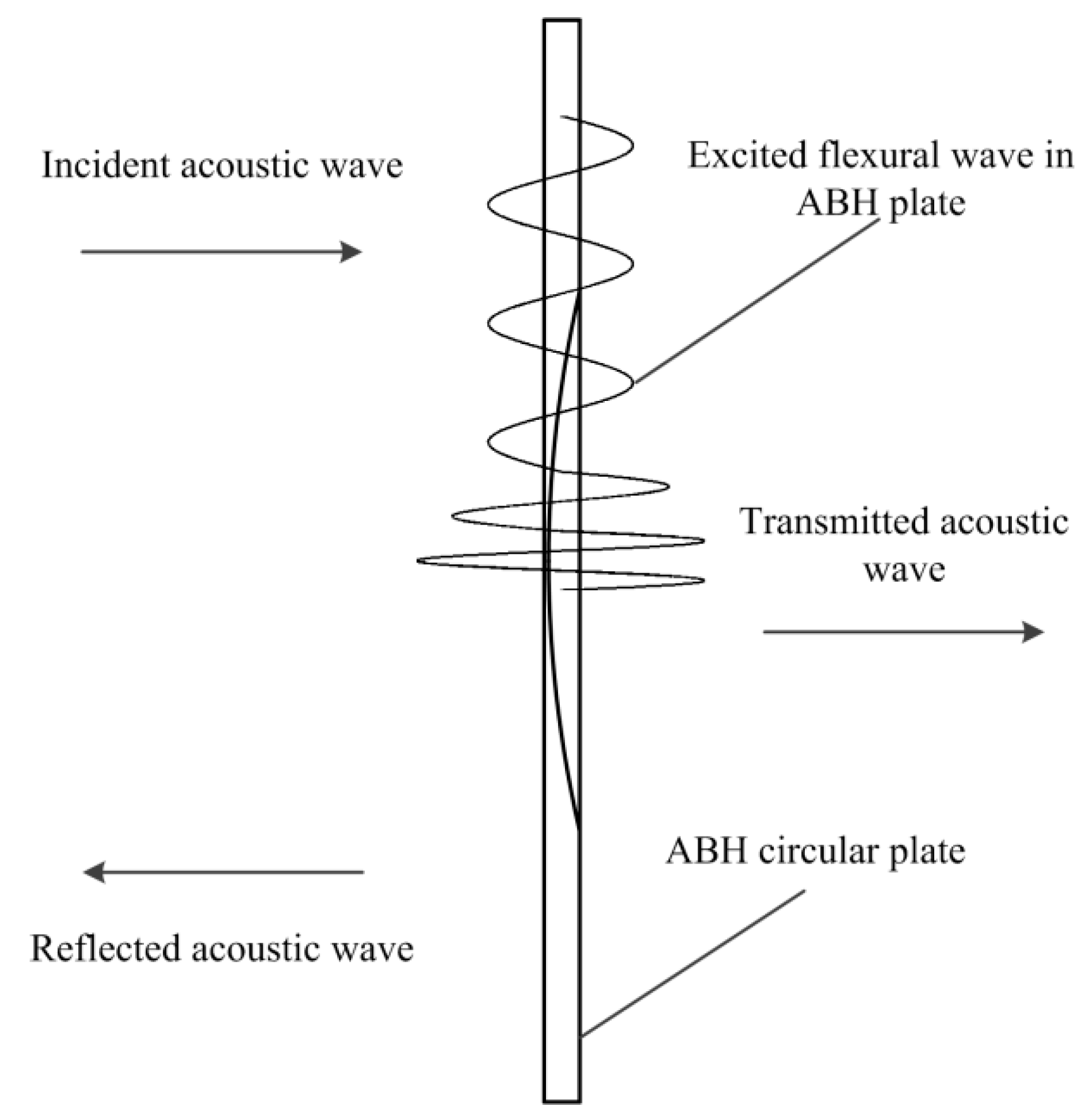

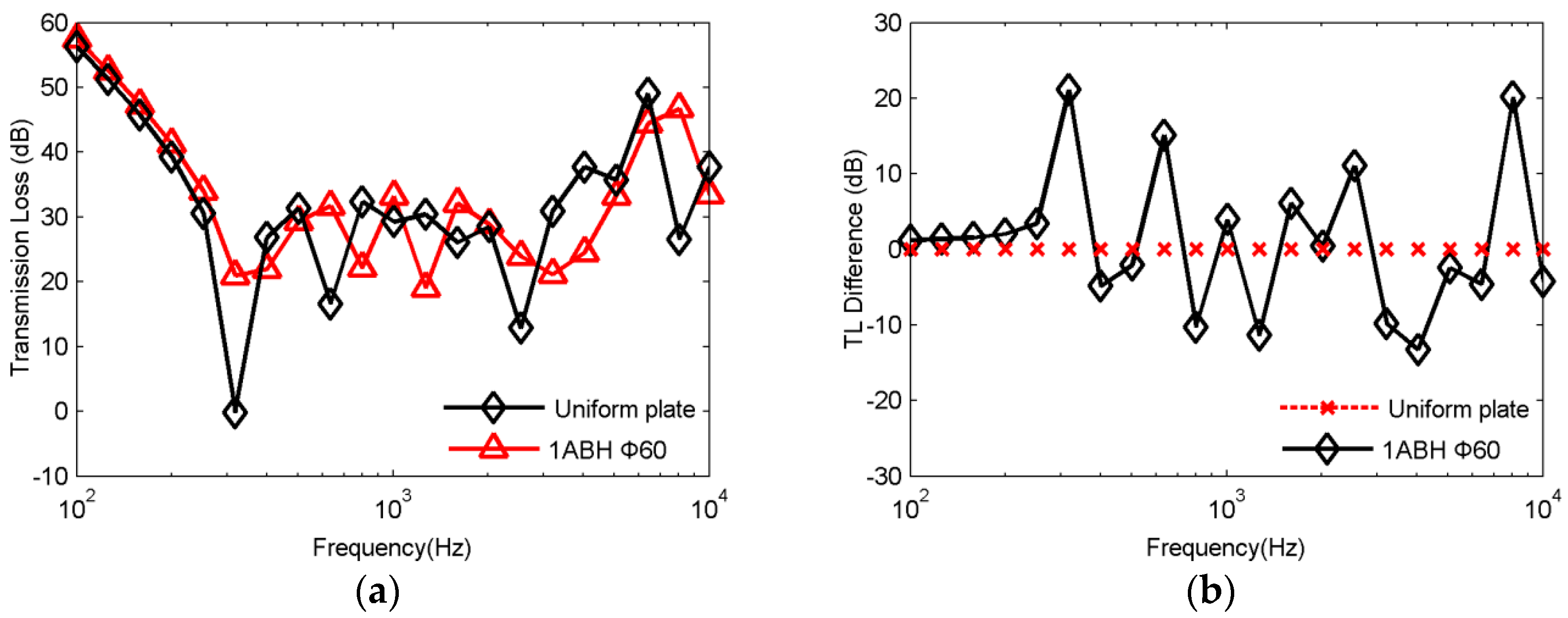

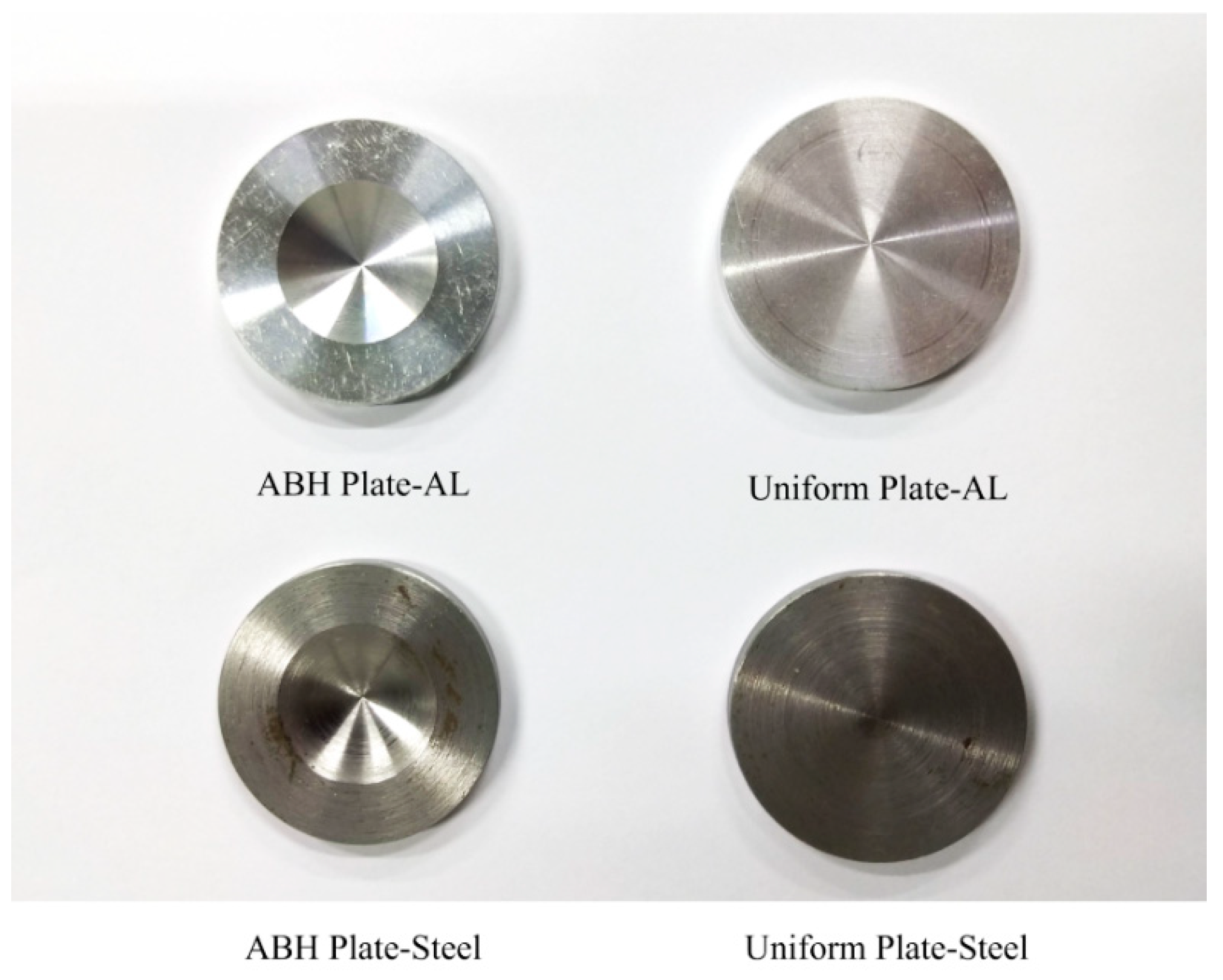


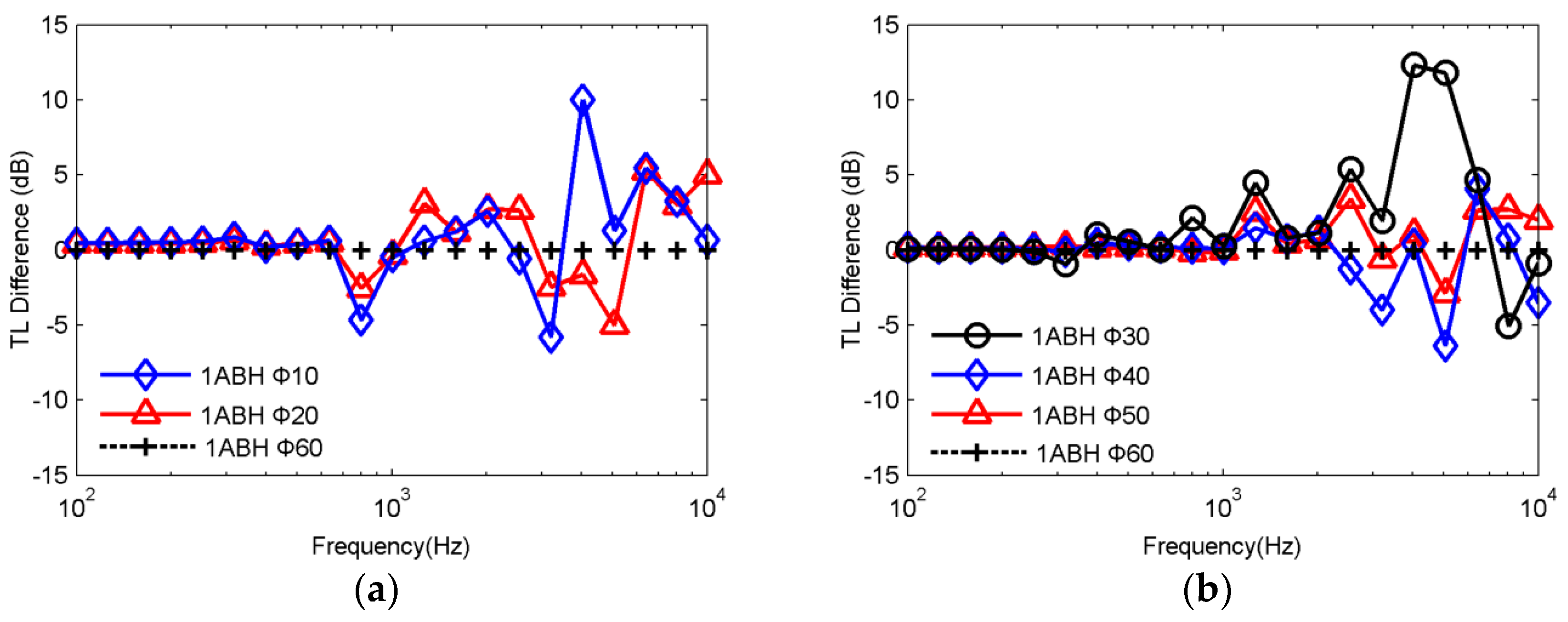
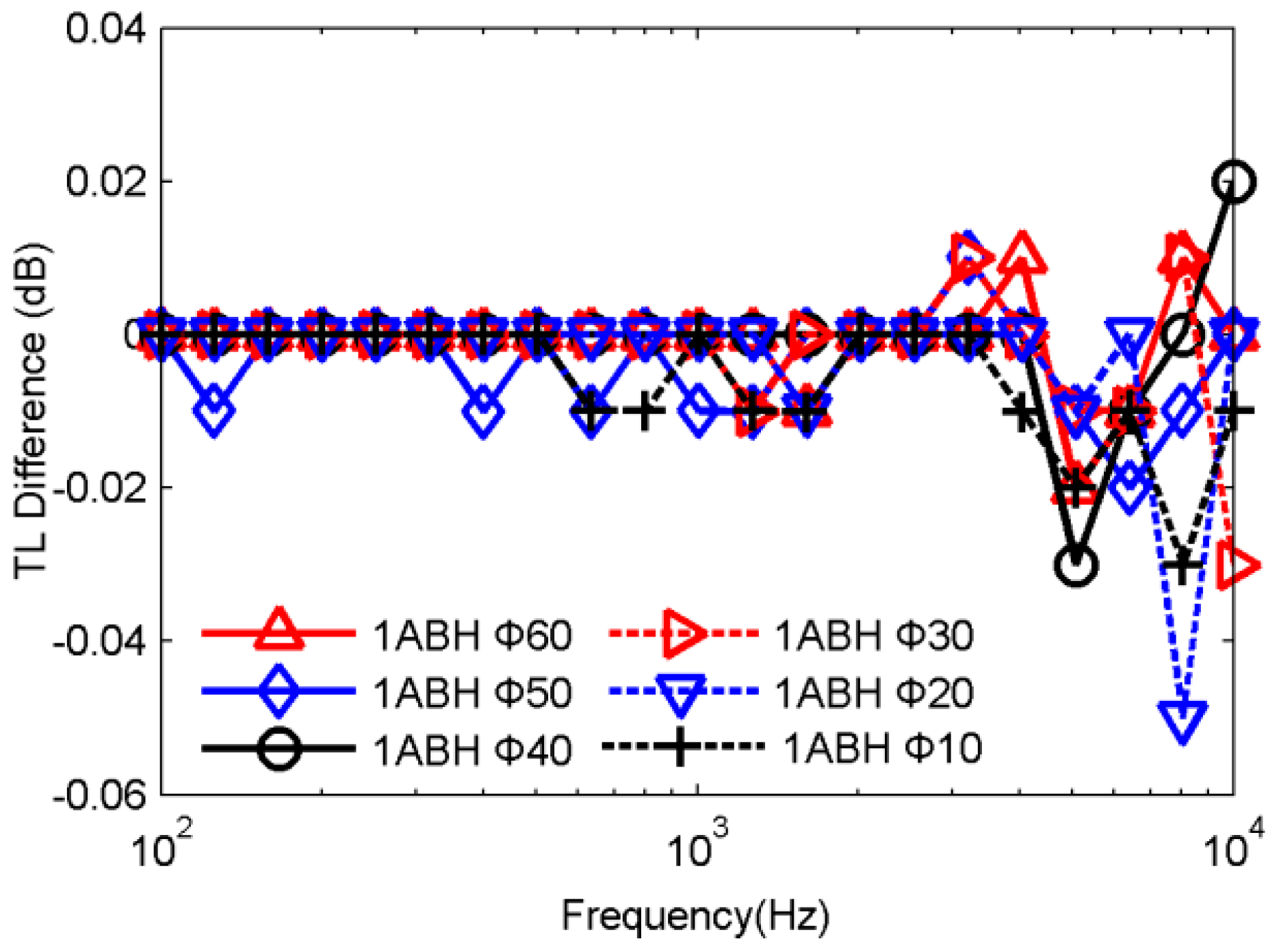

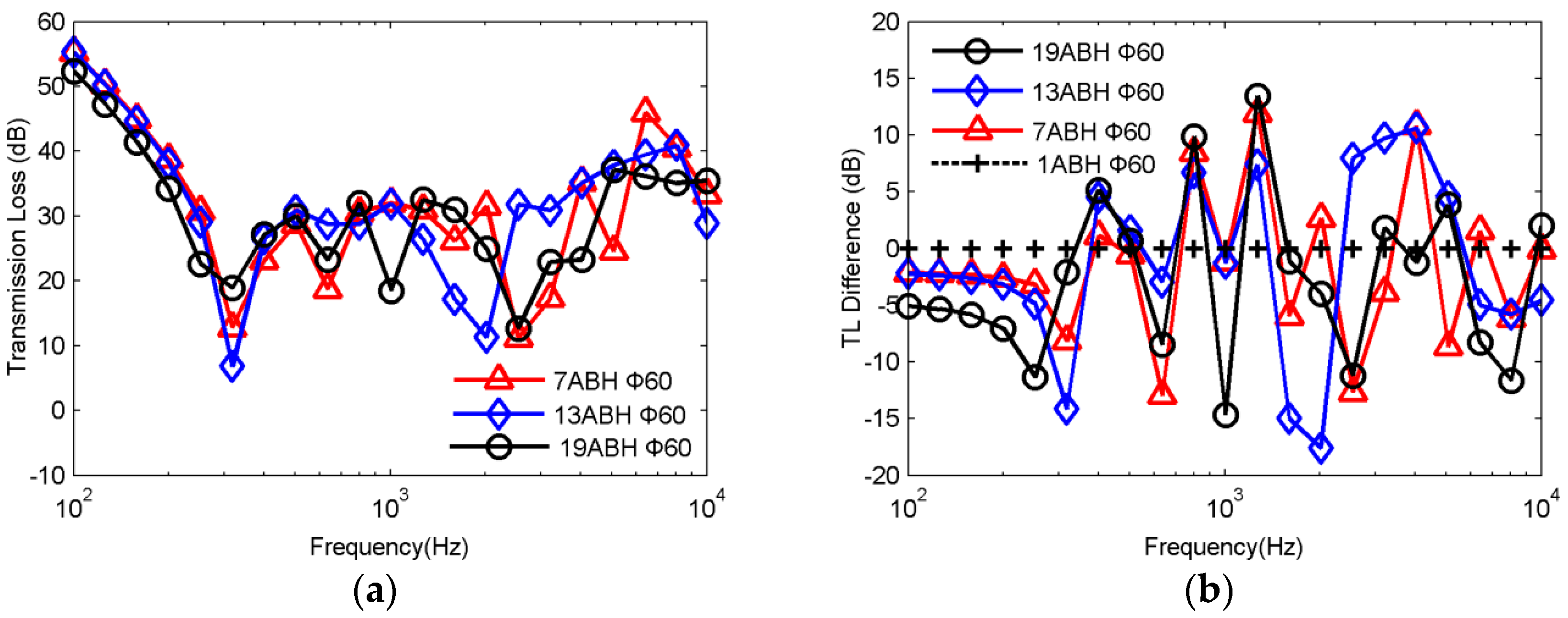

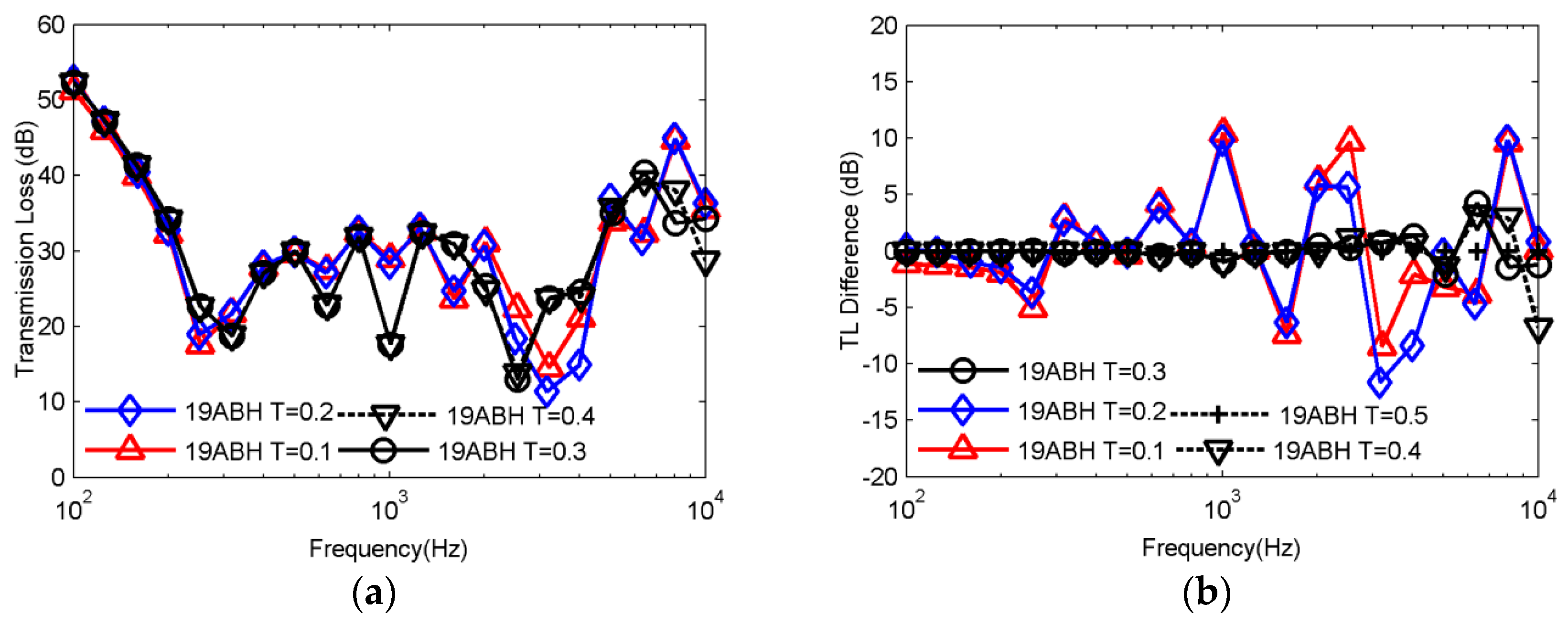

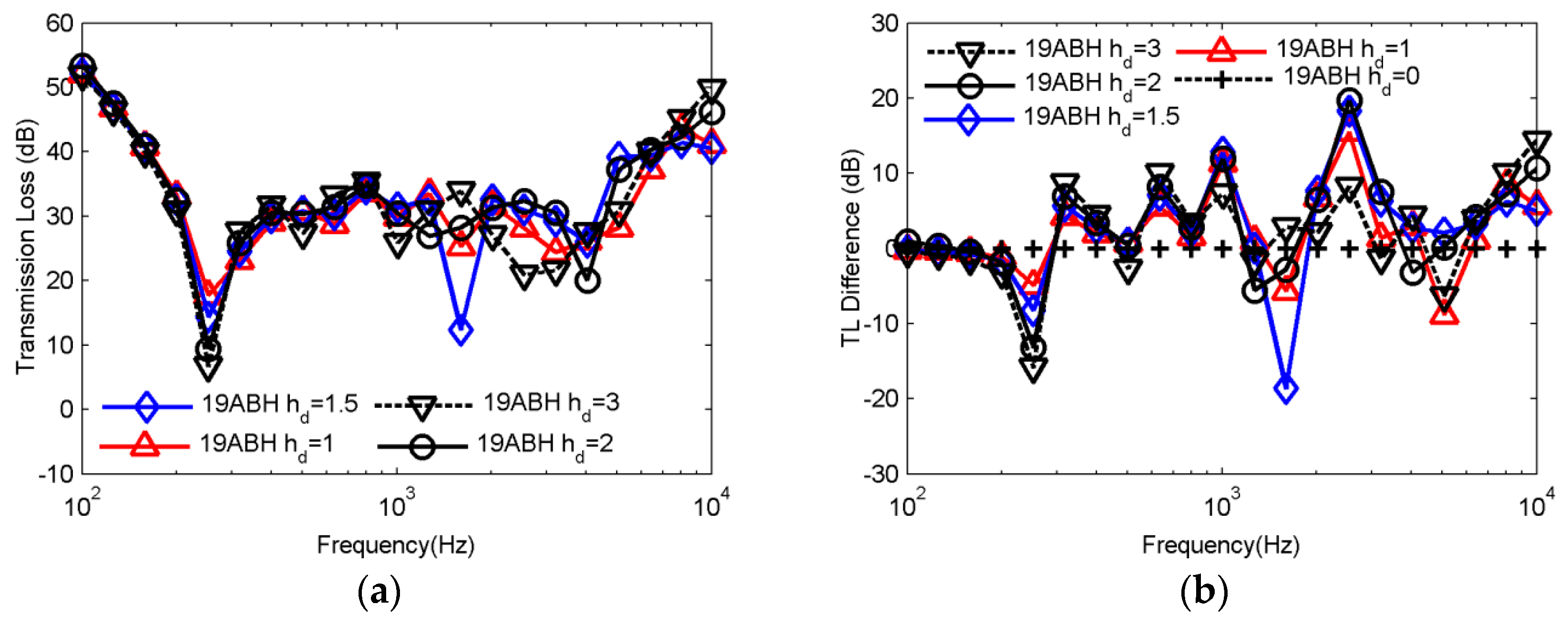
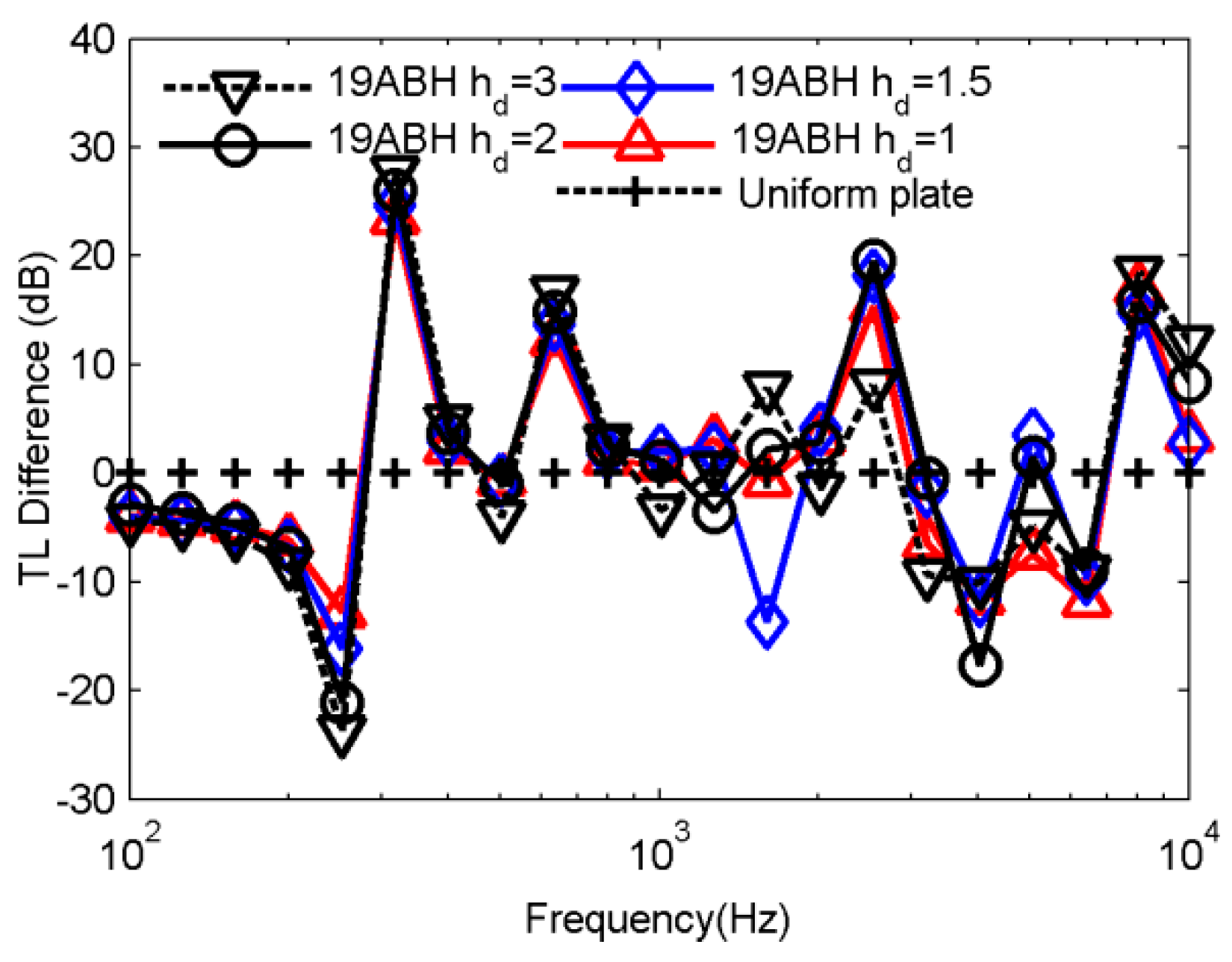
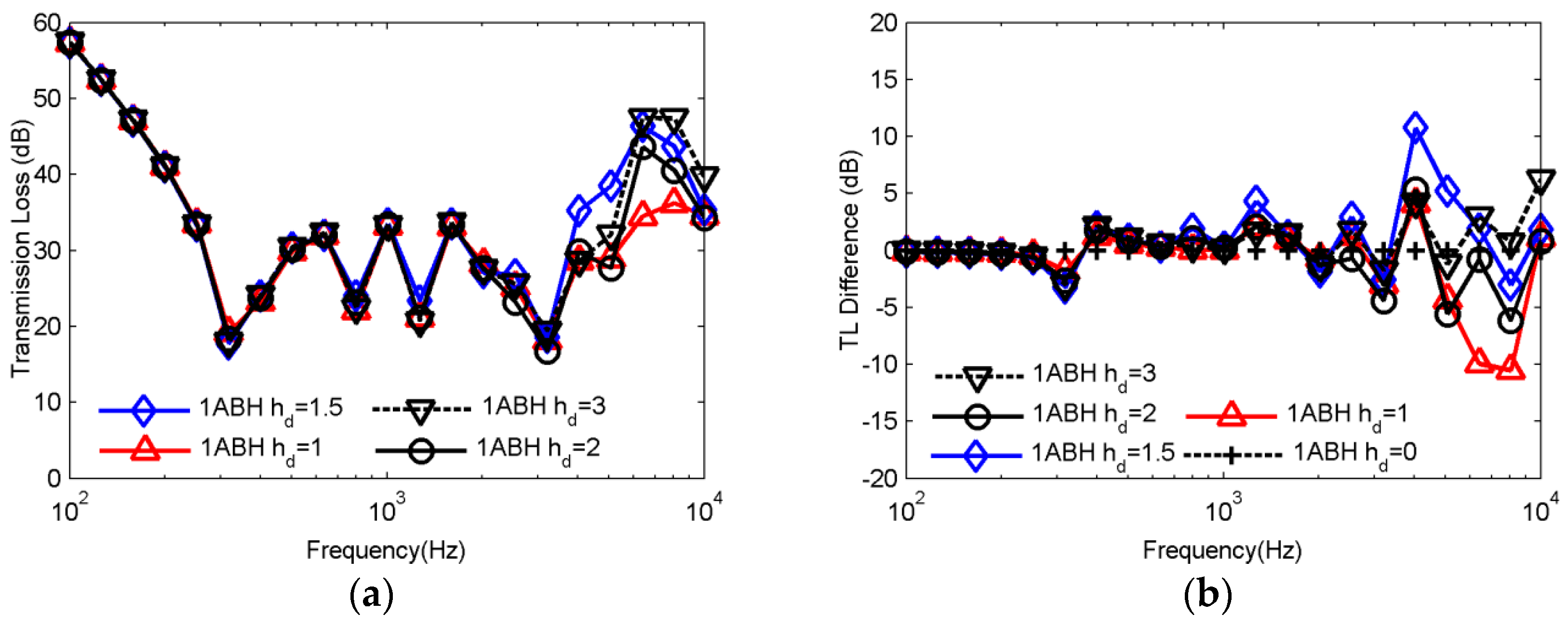


| ε | Power Index | d (mm) | Uniform Thickness (mm) | Truncation Thickness (mm) | ABH Diameter (mm) | Plate Diameter (mm) |
|---|---|---|---|---|---|---|
| 3.89 × 10−3 | 2 | 1.5 | 4 | 0.5 | 60 | 400 |
| Material | Young’s Modulus (Pa) | Density (kg/m3) | Poisson’s Ratio | Loss Factor |
|---|---|---|---|---|
| Aluminum 6061 | 7 × 1010 | 2700 | 0.35 | 5 × 10−4 |
| ε | Power Index | d (mm) | Uniform Thickness (mm) | Truncation Thickness (mm) | ABH Diameter (mm) | Plate Diameter (mm) |
|---|---|---|---|---|---|---|
| 0.035 | 2 | 1.5 | 4 | 0.5 | 20 | 35.5 |
| Material | Young’s Modulus (Pa) | Density (kg/m3) | Poisson’s Ratio | Loss Factor |
|---|---|---|---|---|
| Viscoelastic | 9 × 106 | 1812 | 0.45 | 0.2 |
© 2019 by the authors. Licensee MDPI, Basel, Switzerland. This article is an open access article distributed under the terms and conditions of the Creative Commons Attribution (CC BY) license (http://creativecommons.org/licenses/by/4.0/).
Share and Cite
Du, X.; Huang, D.; Fu, Q.; Zhang, J. Effects of Acoustic Black Hole Parameters and Damping Layer on Sound Insulation Performance of ABH Circular Plate. Appl. Sci. 2019, 9, 5366. https://doi.org/10.3390/app9245366
Du X, Huang D, Fu Q, Zhang J. Effects of Acoustic Black Hole Parameters and Damping Layer on Sound Insulation Performance of ABH Circular Plate. Applied Sciences. 2019; 9(24):5366. https://doi.org/10.3390/app9245366
Chicago/Turabian StyleDu, Xiaofei, Dacheng Huang, Qidi Fu, and Jianrun Zhang. 2019. "Effects of Acoustic Black Hole Parameters and Damping Layer on Sound Insulation Performance of ABH Circular Plate" Applied Sciences 9, no. 24: 5366. https://doi.org/10.3390/app9245366
APA StyleDu, X., Huang, D., Fu, Q., & Zhang, J. (2019). Effects of Acoustic Black Hole Parameters and Damping Layer on Sound Insulation Performance of ABH Circular Plate. Applied Sciences, 9(24), 5366. https://doi.org/10.3390/app9245366






